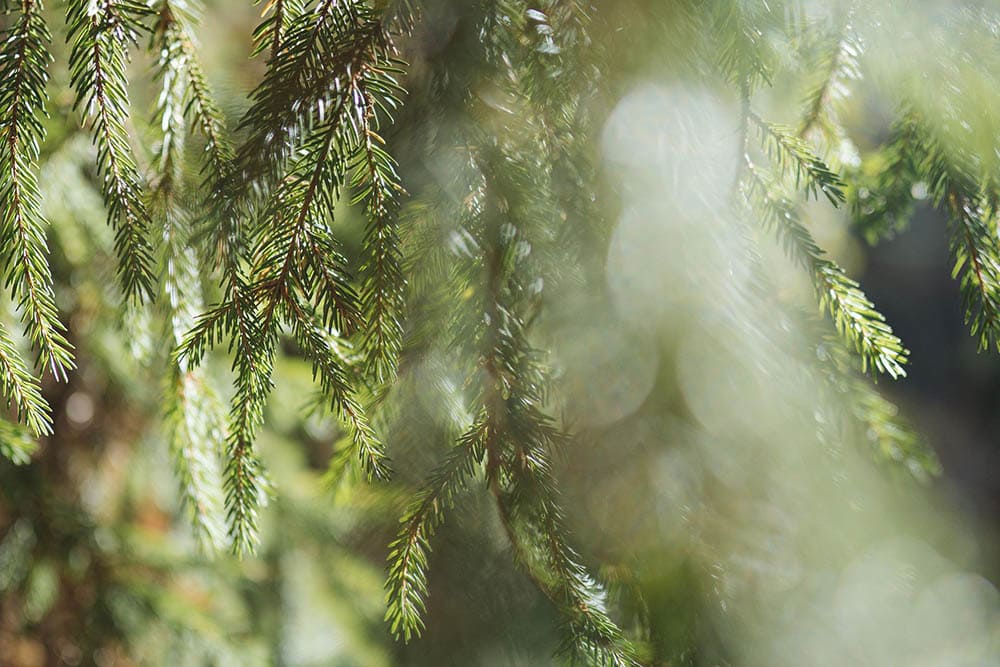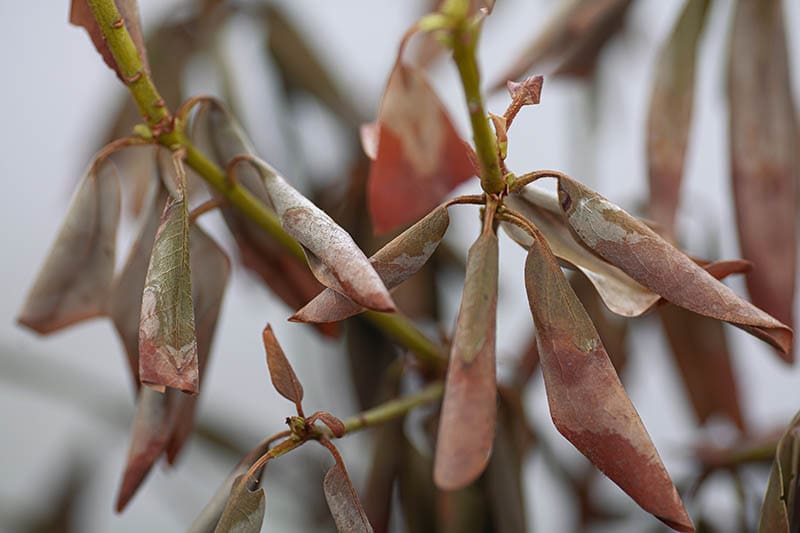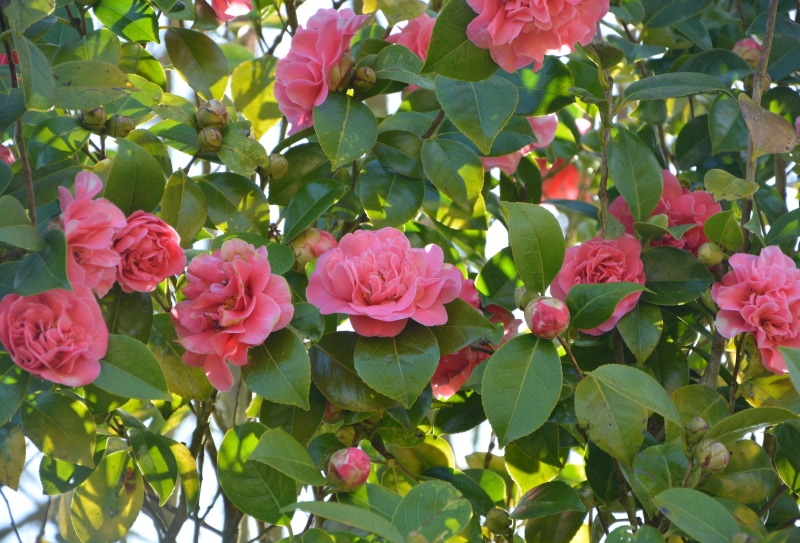16 Evergreens That Grow in Shade (With Pictures)
-

- Last updated:

Evergreen trees are the perfect backdrop to any backyard and make for perfect privacy shrubs in the front yard. These trees include Cedars, Firs, Pines, and Spruces. The great thing about evergreens is that they stick to their namesake and remain green throughout the entire year. Many people love them for their easy maintenance and year-round colors.
Others prefer them because they are great to use for home privacy. So, if you’re looking for a tree that does not require much work and can help you prevent intrusion from nosy neighbors, evergreens are great plants to consider. And if you’re looking to plant evergreen trees, but are worried about the lack of sunlight due to your location, you’ll be happy to know that many varieties grow well in the shade. We’ve covered some of these varieties in this article.
The 16 Evergreens That Grow in Shade
1. Emerald n Gold Euonymus (Euonymus fortunei)
| USDA Growing Zones: | 5 to 8 |
| Flower/Leaf Colors: | Yellow and green |
| Soil Needs: | Moist and well-drained |
This evergreen tree has beautiful bi-colored leaves that are sure to brighten up any front yard or garden. These bushes reach about four to five feet high but can grow taller if you don’t prune them. This plant is quite invasive and it can grow in the shade or tolerate partial to full sun very well.
A lack of sunlight allows it to develop beautiful fall leaves that will stand out once August hits. This plant is fast-growing, so you’ll want to be sure to prune it in early spring before the new bloom. Otherwise, you may find that your leaves may spill over onto the sidewalk or curb.
2. Hetz Japanese Holly (Ilex crenata)
| USDA Growing Zones: | 5 to 8 |
| Flower/Leaf Colors: | White insignificant flowers |
| Soil Needs: | Well-draining soil |
The Hetz Japanese Holly is one of a couple of hollies that tolerates shade fairly well. The leaves on this Holly are a bit smaller than the English and American Holly’s and they have a box shape which makes them stand out.
The Japanese Holly plant has blackberries that are often feasted upon by local wildlife and birds. These plants are popular for front yards as they can easily be shaved to create beautiful designs and add a bit of modernity to your home. This plant tolerates full sun; they can also tolerate shade very well. They also need well-draining soil to thrive.
3. Sky Pencil Holly (Ilex crenata)
| USDA Growing Zones: | 5 to 8 |
| Flower/Leaf Colors: | Greenish white and small |
| Soil Needs: | Well-drained acidic soil |
The Sky Pencil Holly is a Japanese Holly that has a column-like tall shape. These plants are popular as entry door and driveway plants. Their cylinder-like and distinctive shape make them one of the most popular holly plants in the United States.
They’re perfect for tight spaces and corners and the black berries on them attract different types of wildlife (pigeons, robins, and sparrows particularly). These plants can survive very well in partial shade or full sun and they may require pruning in the spring. But, they aren’t the fastest-growing bushes. They’re also very low maintenance.
4. Canadian Hemlock (Tsuga canadensis)
| USDA Growing Zones: | 3 to 7 |
| Flower/Leaf Colors: | Small, yellow or light green |
| Soil Needs: | Acidic, rich, and moist |
Canadian Hemlock trees have needle-like leaves and can be trimmed every spring. The foliage on these plants is very dense, which makes them one of the best evergreens to use for front or side privacy screens.
They make for perfect hedge plants and are fairly hardy, which is why they’re popular in Northern and Northeastern regions. These bushes can survive in partial shade and they have very thick roots. They thrive best in and require acidic, rich soil.
5. English Yew (Taxus baccata)
| USDA Growing Zones: | 4 to 8 |
| Flower/Leaf Colors: | Small, yellow or light green |
| Soil Needs: | Acidic, rich, and moist |
Yew bushes are known for their candy red berries (which contain poisonous taxine alkaloids) and you’ll commonly see them around Christmas time. Real and artificial versions of this particular bush are often used around the holidays to decorate trees, reefs, and fireplaces.
They also work as a great privacy bush and can reach heights up to three to four feet tall if you don’t prune them. They’re pretty open when it comes to sunlight and can tolerate partial shade, full, or partial sun with relative ease. You may want to trim them in early summer as the bushes can grow to be quite wide.
6. Andromeda (Pieris japonica)
| USDA Growing Zones: | 5 to 8 |
| Flower/Leaf Colors: | White |
| Soil Needs: | Moist, slightly acidic soil; should be well-draining |
The Andromeda bush is actually an evergreen and a flowering shrub as well. The flowers are known for their enticing fragrance, which can permeate your entire front or back lawn. They require an acid fertilizer and can become invasive if you don’t trim them yearly.
They tolerate partial shade fairly well, though they’d prefer full sun. It’s important to note that their blooms may be smaller in partial shade. And while in shady areas they’ll still need to be kept in moist soil that’s well-draining and slightly acidic.
7. African Scurf Pea (Psoralea pinnata)
| USDA Growing Zones: | 9 to 11 |
| Flower/Leaf Colors: | White, purple |
| Soil Needs: | Moist and well-drained |
This medium-sized shrub is also nicknamed “the Kool-Aid bush” due to its fruity fragrant flowers. These lilac-blue flowers arrive every spring and have a rosemary-like texture. It’s best to maintain this bush as it can quickly become stringy and less attractive. These plants prefer full sun but can also thrive really well in partial shade. However, the soil should be moist and well-draining in both environments.
8. Alder-Leaved Serviceberry (Amelanchier alnifolia)
| USDA Growing Zones: | 4 to 9 |
| Flower/Leaf Colors: | White |
| Soil Needs: | Moist, well-draining soil |
The Serviceberry plant has small clusters of bluish-purple fruit that are edible. They bloom fairly easily in the spring and are members of the Rosaceae plant family.
This evergreen bush can be prone to powdery mildew and rust, so it’s best to ensure that the plant has enough room for airflow to prevent fungal infection. They tolerate both partial shade and full sun really well and they’re usually grown in zones 4 through 9. They’ll also require moist soil and yearly pruning.
See also: 8 Fruit Trees That Grow in Shade (with Pictures)
9. Alpine Currant (Ribes alpinum)
| USDA Growing Zones: | 2 to 7 |
| Flower/Leaf Colors: | Greenish yellow flowers and red berries |
| Soil Needs: | Prefers moist and well-draining soil; can tolerate drought-like conditions |
The Alpine Currant has bright green foliage and it works perfectly as a bordering or a privacy hedge. This evergreen shrub produces colorful ornamental berries, though they aren’t edible. It thrives well in partial shade and full sun and the blooms will be full every year with little maintenance. Soil should be well-draining and moist, though the plant can tolerate drier conditions more than other similar varieties.
10. Spotted Laurel (Aucuba japonica)
| USDA Growing Zones: | 7 to 9 |
| Flower/Leaf Colors: | Reddish-purple |
| Soil Needs: | Moist, well-drained soil, rich |
The Spotted Laurel is a popular evergreen shrub that has purple reddish leaves and grows up to about 13 ft. tall. The leaves have an elliptical shape and a glossy finish that almost makes them look artificial.
It blooms regularly in the spring with small flowers and it should be fertilized once a year (with acidic fertilizer) to ensure a full bloom. These plants thrive well in partial shade or full shade, so they’ll work well as privacy or backyard plants.
11. Rhododendron (Rhododendron)

| USDA Growing Zones: | 4 to 9 depending on the variety |
| Flower/Leaf Colors: | White, pink, yellow, purple, red |
| Soil Needs: | Acidic, well-draining |
The Rhododendron bush has beautiful and colorful blooms that come in purple, yellow, red, and white. This gorgeous Bush can grow up to 10 to 15 ft. high and should be pruned regularly if you want to keep it short. It can be particularly invasive, which actually makes it perfect for a privacy bush.
It prefers heavily acidic fertilizer, and it’s best to apply it annually in early spring or late winter. These bushes thrive best in partial shade conditions.
12. California Sweetshrub (Calycanthus occidentalis)
| USDA Growing Zones: | 6 to 9 |
| Flower/Leaf Colors: | Deep red |
| Soil Needs: | Moist and loose soil |
The California Sweetshrub is another popular shrub that has beautiful deep red leaves and survives well and partially shady conditions. It’s a low-maintenance plant that is popular amongst riverbanks and small creeks. The flowers produce an enticing fragrance that is said to resemble that of red wine.
The plant will need to be pruned every year, as overgrown stems can cause issues in your yard and lead to water distribution issues. It’s also worth noting that this plant doesn’t tolerate drought well, so it’s best to keep the soil moist, especially during the spring and summer months.
13. Camellia (Camellia sinensis)

| USDA Growing Zones: | 7 to 9 |
| Flower/Leaf Colors: | White or pink |
| Soil Needs: | Rich, acidic, well-drained loam |
Camellia plants make for great yard plants and home privacy screens, and they’re also used to make fragrant tea. It’s a slow-growing shrub, which makes maintenance fairly easy and extends the life of the plant. It loves partially shady conditions and thrives with rich and acidic soil (that should also be well-draining). The blooms produce beautiful pink or white flowers with a delightful smell and leaves that have a glossy finish.
14. Checkerberry (Gaultheria procumbens)
| USDA Growing Zones: | 3 to 8 |
| Flower/Leaf Colors: | White or pale pink |
| Soil Needs: | Low nutrient and good drainage |
The Checkerberry plant, also known as the American Wintergreen, is known for its minty scent, due to its red edible berries. It’s a relatively small shrub and typically only grows until it reaches about two to three feet in height.
It prefers acidic soil that has good drainage, though it doesn’t need a lot of nutrients. It’s best to prune the plant in early spring or late winter and it survives well in partial shady areas. This plant produces pale pink or wide leaves and is fairly hardy.
15. Coast Leucothoe (Leucothoe axillaris)
| USDA Growing Zones: | 5 to 9 |
| Flower/Leaf Colors: | White flowers |
| Soil Needs: | Acidic soil |
The Coast Leucothoe plant is another popular evergreen that can be used for privacy. It tolerates shady conditions really well. The Coast Leucothoe’s springtime bloom has small, urn-shaped flowers in bunches that look similar to the Japanese Andromeda.
It’s also commonly used as a hedge or boundary plant and prefers acidic soil. To improve the acidity and moisture retention, many gardeners add a good deal of peat moss up to 18 inches before planting.
16. Red Tip Photinia (Photinia x fraseri)
| USDA Growing Zones: | 7 to 11 |
| Flower/Leaf Colors: | White |
| Soil Needs: | Well-drained with loam or sandy |
The Red Tip Photinia is an evergreen shrub that has red or green leaves–older leaves are green. The plant will continue producing new leaves all year, so you can prune the green leaves all throughout the late summer and fall.
It can grow up to 10-12 feet in height, depending on how much sun it gets. However, it can survive and grow well in partial shade. This shrub is low-maintenance and great for privacy screens and hedges.
Conclusion
Some evergreens can be large, elegant trees while others are small bushy shrubs. There are many evergreen trees that can be used for landscaping, privacy and screening, and ornamental purposes.
Many evergreen trees can withstand extreme climates and are woody, hardy plants. It’s best to consider the growing zones and cold hardiness of any evergreen before you choose one for your garden.
Read More:
- 11 Trees that Grow in Shade (with Pictures)
- How and When To Plant Lilac Bushes – What You Need To Know
Featured Image Credit: FoYu, Pixabay
Contents

